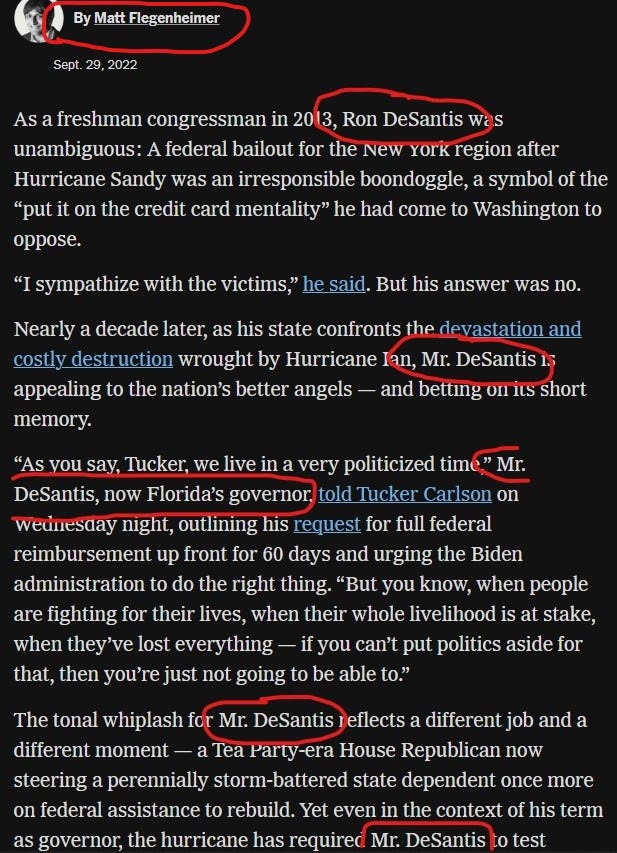You’re Not Supposed To Notice These News Edits
See how the same news article written by the same journalist reads differently across two publications, edited to manipulate how readers perceive it.
Intro
The New York Times published an article about Gov. Ron DeSantis (R-FL) requesting federal aid from the Biden administration for Florida after Hurricane Ian. Orlando Sentinel picked up the story from the Times, but made subtle edits to tone down the language and use the governor’s proper title before publishing it. Revealed here is how publication context affects an article in digital media, and how readers aren't alerted to the different experiences.
Evidence
Exhibit A
Look at the marked up screenshot below of the article published in the Times.
Exhibit B
Now, look at the marked up screenshot of the same article by the same journalist, Matt Flegenheimer, published in Orlando Sentinel.
Exhibit C
Realize that this article wasn’t published as an opinion piece. It was intended as straight news reporting.
Discussion
There are two major differences between the articles, as marked up by the screenshots.
First, DeSantis is never addressed properly as governor in the Times article (“Mr.” instead of “Governor” or “Gov.”), but he is in the Orlando Sentinel article (at least once as “Gov.” but never as “Mr.”). It’s unlikely that the Times simply missed such a repetitious error—it was more likely bias by word choice, a subtle refusal to legitimize the governor’s position.
NB: After the first reference to DeSantis, a tense shift tells us we’re talking about the governor, not the congressman, meaning his title changes from “Mr.” to “Gov.”
Second, the Times headline ends with sensationalist/emotionalist language (“President He’s Bashed”), but the Orlando Sentinel headline ends with neutral language (“Biden for help”).
The article was first published in the Times, which means Orlando Sentinel edited the article to properly address the governor and tone down the language in the headline. This is important because a common practice in journalism is for outlets to copy, paste, and publish stories from other outlets without edits. Orlando Sentinel clearly thought the edits were important enough to make, changing how readers perceive the article.
That said, both the Times and Orlando Sentinel demonstrate a skew left bias, and thus oppose DeSantis, but the Times is farther to the left and is a New York publication, hence the more biased appearance of the article. The inclusion of the article in the 2022 midterms coverage implies the Times meant to influence election results against DeSantis rather than to simply report the facts on politics. Indeed, libertarian newswire Reason cites the Times article as an example of New York Democrat bias against DeSantis.
Meanwhile, Orlando Sentinel is closer to the center and is a Florida publication, hence the edits to make the article appear more moderate when presenting the Florida governor requesting aid for Florida.
Conclusion
The moral of the story here is twofold. While perhaps not technically examples of unethical bias, there may be ethical questions about digital media practices.
First, this example shows how an editor can alter the same article to read differently in a publication, regardless of the journalist’s intent or whether the article was meant as straight news reporting.
Second, neither publication credits an editor or offers a list of the edits made, which means most readers won’t know that their experience with this article (and by extension the journalist) depended on the publication they read it in.







